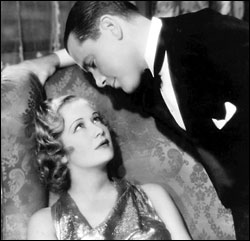
Somehow I got the impression that this film was worth watching; I think “Entertainment Weekly” rated it highly. Just goes to show you can’t trust a movie critic whose publication is owned by Time-Warner.
The film is based on the book “Howl’s Moving Castle,” by Diana Wynne Jones. I haven’t read the book, but reviews suggest that the film retains the book’s spirit pretty well. If so, it makes sense that a Japanese filmmaker, Hayao Miyazaki (“Princess Mononoke”), was chosen to direct the animated film. Like every other animated Japanese movie I have seen, “Howl’s Moving Castle” evokes the reverence for nature, the disdain for war and weapons, and the complex characters that are the hallmark of Japanimation. Unfortunately, the film is also plagued by the bizarre, out-of-left-field mysticism and incomprehensible storyline that is also a hallmark of Japanese animation. Every film I have seen from this genre, from “Final Fantasy” to the beloved “Akira,” has been the same way. They start out well enough, with great animation, intriguing characters, and good action. Somewhere around the middle, though, these films veer off into storylines based on some sort of animistic magic that must make more sense to the Japanese than it does to me.
“Howl’s Moving Castle” is about Sophie, a sensible, serious girl who gets turned into an old woman by a spiteful witch. After the initial shock, Sophie takes this surprisingly well, with the droll observation that, “At least my clothes suit me now.” In her rickety new old body, she heads out into the wilderness in search of the infamous wizard Howl and his walking castle. She hopes that Howl (who never actually howls, by the way) will break her spell, but he ends up being such an emotional mess that she has to save him instead. Two kings are at war, and each demands Howl’s loyalty. Meanwhile, the Witch of the West, who cast that aging spell on Sophie, wants to literally steal Howl’s heart. Sophie tidies up the moving castle and helps the moody, androgynous Howl keep it together, while a fire demon named Calcifer (voiced by Billy Crystal) keeps the castle moving. The un-self-conscious Sophie is a perfect foil for the vain, but well-intentioned Howl (who maybe should have been named Cry or Whine).
“Howl’s Moving Castle” does have some things to recommend it: Billy Crystal’s Calcifer is amusing, and I really liked the Sophie character. The animation is beautiful, and the flying machines and moving castle looked really cool. Still, by the time the credits rolled, I felt like I had been ripped off. The movie is about 30 minutes too long, and that half hour is filled with mostly incomprehensible magic-related crap that fails to explain all the intriguing mysteries introduced earlier in the story. In the translation from an English book to a Japanese movie and back to English, some clarity was apparently lost.
Or maybe not. As I mentioned before, every animated Japanese movie I have seen seems to run into the same problem, getting mired in Earth-spirit mysticism that leaves me scratching my head. I’m sure some of this is just a cultural difference. We Americans tend to associate Japan with crowded cities and technology, but Japan is actually a naturally beautiful country, and a reverence for nature seems to be a part of the Japanese character. There also seems to be a romantic yearning in Japan for the feudal past, represented by the image of the noble Samurai. It helps to recall that the Japanese embraced industrialization only as a response to American military might (Anyone remember the Great White Fleet?). The Japanese attitude was also shaped by having two of their cities nuked in WWII, and this influence is seen in many of their films. I don’t know, though. I am hesitant to blame my problems with Japanese animation on Japanese culture, seeing as how I have thoroughly enjoyed live action Japanese movies like “Seven Samurai” and “Yojimbo.”
Whatever the reason, I don’t dig Japanimation, and I dug “Howl’s Moving Castle” less than most. Check it out if you want, but don’t come crying to me, and don’t ask me to explain the plot.
2 stars out of 5.






